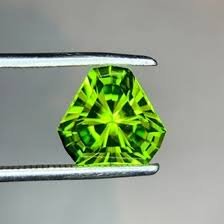


GEMOLOGICAL PROPERTIES OF PREIDOT

Mineral: Olivine
Chemistry: (MgFe)2SiO4
Color: Yellowish green
Refractive index: 1.65 to 1.69
Birefringence: 0.035 to 0.038
Specific gravity: 3.34
Mohs Hardness: 6.5 to 7
Chemical Composition:
Peridot is a variety of the mineral olivine, and its chemical composition is (Mg, Fe)2SiO4. The green color comes from the presence of iron.
Color:
Peridot is typically green, and its color can range from yellowish-green to olive green. The intensity and saturation of the green color contribute to the gem’s overall value.
Color Origin:
The green color in peridot is caused by the presence of iron. The amount of iron in the crystal structure influences the hue and tone of the gem.
Clarity:
Peridot is often found with few inclusions, and eye-clean specimens are common. However, some may contain tiny mineral inclusions or “lily pad” inclusions, which can be used to identify the gem.
Cut:
Peridot is typically faceted to enhance its brilliance and showcase its color. The most common cuts are oval, round, emerald, and pear shapes.
Carat Weight:
Peridot is available in various sizes, and larger stones without compromising color or clarity are rarer and more valuable.
Mohs Hardness:
Peridot has a hardness of 6.5 to 7 on the Mohs scale, making it softer compared to some other gemstones. Care should be taken to prevent scratches. If you are looking for bracelet. There’s something to suit every look, from body-hugging to structured, from cuffs to chain chain bracelet and cuffs.
Luster:
Peridot displays a vitreous (glass-like) luster, giving it a bright and reflective appearance.
Specific Gravity:
The specific gravity of peridot ranges from 3.27 to 3.37.
Refractive Index:
The refractive index of peridot ranges from approximately 1.654 to 1.690.
Cleavage:
Peridot has poor cleavage in two directions at right angles.
Heat Sensitivity:
Peridot is sensitive to rapid temperature changes, so it is advisable to avoid sudden temperature fluctuations when handling or cleaning the gem.
Origin:
Peridot is found in various locations, with notable deposits in Egypt, Myanmar, Pakistan, Arizona (USA), and China. The origin can sometimes influence the gem’s color and quality.
Treatments:
Peridot is usually untreated, but some gems may undergo heat treatment to enhance their color. Heat-treated peridot is still considered natural and is widely accepted in the industry.
Understanding these gemological properties is essential for gemologists and buyers when evaluating the quality and value of peridot gemstones.












